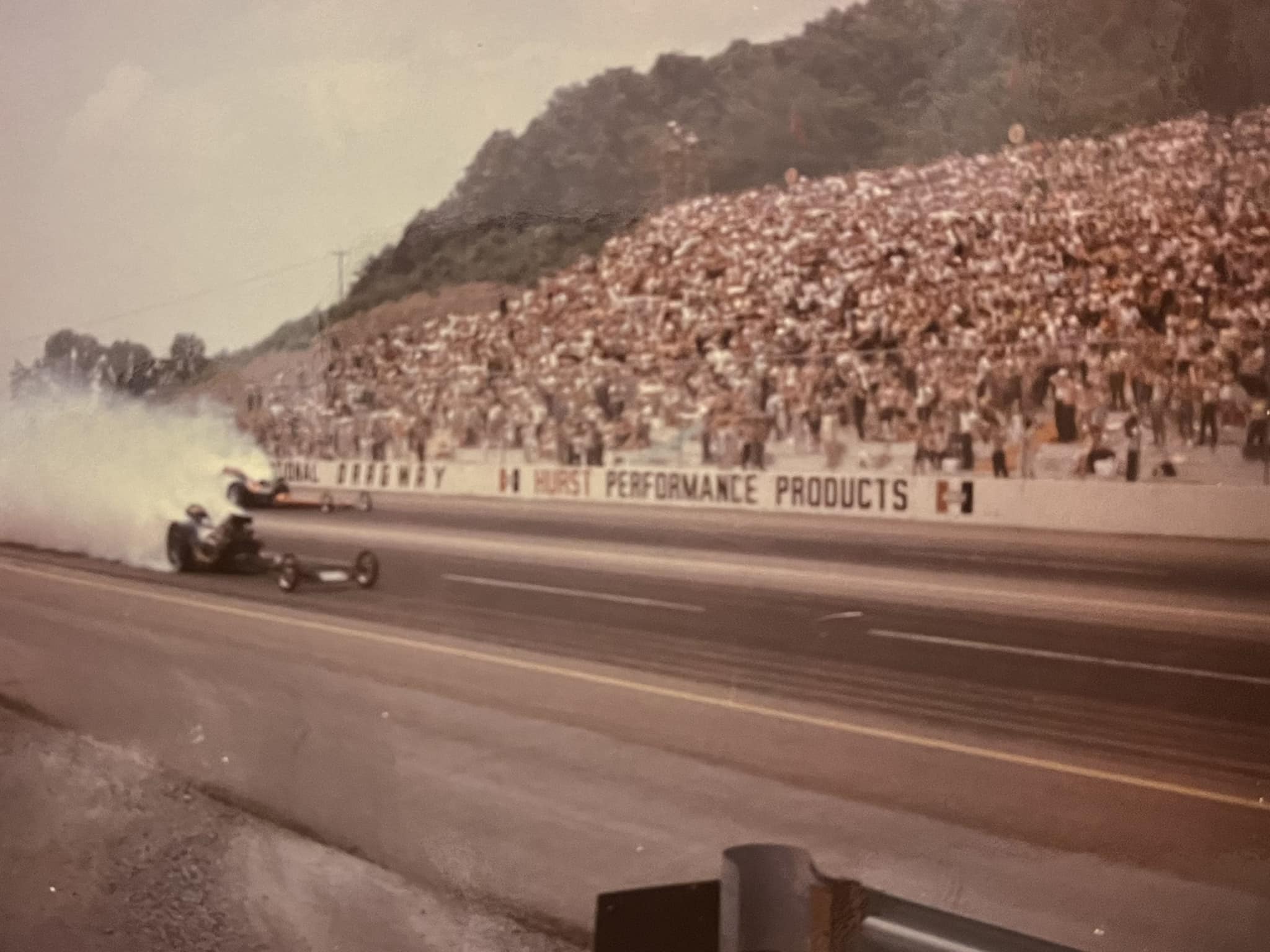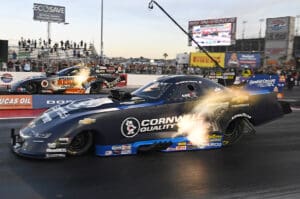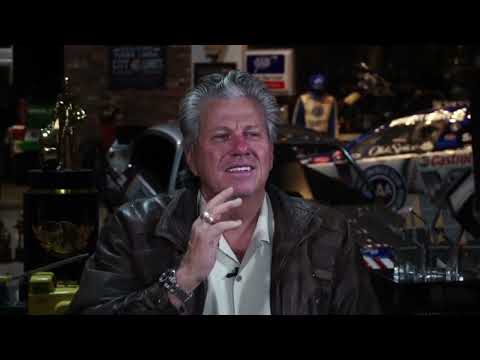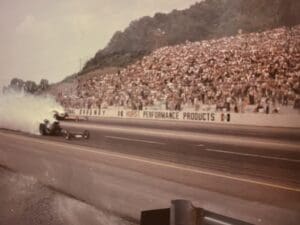Originally published May 2005
Away from the Fanfare, Drag Racing Grew Because of Larry Carrier …

When one talks about the legends of drag racing, Larry Carrier’s name rarely is mentioned as often as it should be.
Every drag racing fan in the country should know of Carrier’s commitment and accomplishments in the sport.
He built one of drag racing’s more legendary facilities carving a drag strip from between two mountains in the mountains of northeast Tennessee.
He founded drag racing’s second oldest sanctioning body.
He introduced R.J. Reynolds as the first major series sponsor in drag racing.
If Carrier were still alive, he’d prefer to operate in the shadows. As long as his team received the respect and admiration they deserved, he was content.
Disrespect his team, whether it was the famed Thunder Valley Dragway in Bristol or his beloved International Hot Rod Association, and you’d encounter his wrath.
Tens of thousands of drag racing fans will walk through the turnstiles at this weekend’s NHRA Thunder Valley Nationals at the revamped Bristol Dragway.
Gone is the IHRA sanction, replaced in 1998 by the NHRA.
Gone is the traditional reverberation throughout the “valley”, replaced with a more high tech rumble. The tower which Carrier once built as a source of pride and Wally Parks proclaimed would be a constant reminder of his failure, is long gone.
It was bulldozed as Bruton Smith’s high tech renovation erased the reminder of what the track used to be. When cars launch off the starting line this weekend, just remember that’s where Carrier and his staff pondered their future.

Bristol Dragway was once Larry Carrier’s playground.
He wasn’t the bully at recess, he was the kid who wouldn’t take crap from anyone.
Carrier, who died in 2005 at the age of 82 from Alzheimer’s disease, created an existence in drag racing out of necessity. Drag racing became a passion for Carrier and he needed it.
Little did he know that drag racing needed him just as badly.
In 1970 when drag racing needed a rebel, Carrier fit the bill perfectly.
Carrier was an opinionated track operator with one of the most state of the art facilities of the era. He had hosted the 1965 NHRA Springnationals with a strong level of success but when he had a disagreement with the late Buster Couch and later another NHRA official, he didn’t hesitate to tell them to go pound sand. He later moved over to the American Hot Rod Association but after a disagreement with one of their high ranking officials (he reportedly kicked the official off of the property), he dropped their series.
Its been reported that Carrier and then partner, former Senator Carl Moore, stood on the grounds of their hallowed facility, where the politician reportedly asked Carrier of his future plans.
The conversation was said to have transpired like this.
“Well, we no longer have the NHRA and now you just threw the AHRA out, what are we going to do?” Moore asked Carrier as they looked out over their empty facility. “There are no other sanctioning bodies.”
The quick witted Carrier responded, “We’ll just start our own.”
Thus was born the legend of the IHRA and Larry Carrier.

Carrier could deal with legends as long as they didn’t have the title prima donna attached them. He didn’t deal with a holier than thou attitude very well.
He was the kind of person people either loved or hated.
Carrier began first as a track promoter but the formation of the IHRA eventually consumed him. He was the savior to those track operators who felt like outcasts with both the NHRA and AHRA.
Ted Jones, now a television producer for Masters Entertainment, was one of those disheartened strip operators. He would eventually become Carrier’s right-hand man in 1975 and remain with the sanctioning body until Carrier sold out in 1988.
“The IHRA grew like crazy because of the charisma that Larry extended to them,” explained Jones. “The thing that the IHRA had most in their favor was that they did it differently. The IHRA would go in and negotiate on a partnership/barter basis. It wasn’t always 50/50 like it is today. If you had a really good drag strip and you thought you’d do well, you could tell Larry that you wanted more or less. If, for instance, someone wanted to have 70 in a 70/30 split, if Larry thought that was a good deal, he’d take it. His deal was simple. Win, lose or draw … that was your percentage. If they lost money – that was the split, no matter what.”
That kind of flexibility was something the other sanctions wouldn’t (or couldn’t) extend.
Carrier’s IHRA ship didn’t always float in calm waters and struggled financially in those early days. Still he proved a worthy captain in the rough seas.
Carrier’s ability to keep the company afloat was in direct proportion to his characteristic of being a keen bean counter. He garnered a lot of production from a small staff and left people in awe at the ability to make it all work. The small staff remained very loyal to their leader because he never was too busy to pass on his appreciation.
Carrier saw the big picture of drag racing and when he attracted Ralph Seagraves of Winston into drag racing as sponsor of the IHRA, he knew that for his newly signed client to get the largest bang for their buck that he had to introduce them to the NHRA – which he did.
He didn’t dislike Parks personally, he was just competitive.
Carrier was never one to mince words either in face to face meetings or in the media.
“We had a problem trying to keep Larry down because sometimes he would drift far out into left field,” said Jones. “We were worried about liability lawsuits and everything else. We would try to tone him down, but he was a plain spoken person. With Larry, you always knew where you stood. He was real plain.”
Carrier didn’t shy away from feuds with anyone. He had one in the early going with Shirley Muldowney over some press disagreements and the two never patched up their differences during Carrier’s tenure.
“If anyone wanted to feud and throw mud, Larry was like a big kid with a squirt gun,” Jones recalled. “The minute someone was ready to get it on, he was right there ready. He picked on Shirley a lot. I think he did it a lot for the publicity because people were still amazed that he dare do something like that. He would come up with little slams and digs. He would know how far he could go without turning people against him. He knew when to stop and when he was close to going over the line.”
Carrier had a way of keeping people talking and he found a way of attracting the big names of the sport. He followed AHRA founder Jim Tice’s lead in paying appearance money to drag racing’s largest stars.No two racers had the same incentive money. For instance, one might be offered a guaranteed minimum of third round money or in some instances if the posted purse was $500, a name racer might take home $800. It didn’t take long for Carrier to attract the top names of the sport. Some of those that rolled through the gates in that first year included Raymond Beadle, Muldowney, Don Garlits, Don Prudhomme and Tom McEwen, Bob Glidden, Gapp & Roush and Ronnie Sox were all there at the early events.
“It worked,” Jones added. “He had the names to put on his advertising and that attracted the fans. It worked very well and for that reason, the IHRA was an almost instant success. The big names were always determined by what they did in NHRA competition. If you did well over there – you were considered a big name.”
In fact, in 1980, Carrier and Jones made the decision to stop paying appearance money for the premiere Bristol Spring Nationals and instead increased the purse to the point that $20,000 was paid to win Top Fuel and Funny Car respectively. The Pro Stock winner took home $10,000. Just to give you an idea of how far ahead of the time that he was, the current pay structure for the NHRA pro winners is in the same ballpark.
NHRA in 2005 paid $40,000 to the winner of a nitro category. Carrier’s $20,000 of 1980, with inflation would be equal with at least $100,000..
Often times he made decisions and he stuck to them, good or bad. One of his more questionable moves was the decision to not run Bristol as a weekly track. His motives served to create the reputation that the only way his track would open would be for a big event. That reputation would serve to drive more spectators to his special events, regardless of the ticket prices. While many might question his logic, Carrier was just following the lead of NASCAR. Their track operators had done the same thing. Bristol’s logic was passed on to Rockingham and the theory spread throughout the sport.
Few could con Carrier into something.
Once a prominent NHRA facility considered IHRA sanction and offered the notion his previous event had attracted 15,000 spectators and over 500 race cars. Prior to the meeting Carrier and Jones had used their years of experience to determine the capacity to be 2,500.
The track owner gave what was deemed as bogus numbers and the two turned around to walk off, leaving the promoter talking to himself.
As Carrier walked to the car, the unnamed promoter followed and was trying to make reason of what happened. Reportedly Carrier turned to the gentleman as he sat in the car and uttered, “I’ll tell you sir … any man that can put 15,000 people in 2,500 seats is either a damn liar or a magician and I don’t want to do business with either one.”
That’s how Carrier rolled.
Once CompetitionPlus.com’s Jon Asher asked Carrier a pointed question, aimed at stirring controversy. Asher asked Carrier what’s the most beautiful drag strip he’d ever seen fully expecting him to respond by naming his own facility.
Carrier read right through his Asher’s intentions and promptly answered, “A full one. That’s the most beautiful one I’ve ever seen.”
Carrier’s early success was due to his willingness to implement NASCAR philosophies into his business model. Few knew that Carrier considered NASCAR founder Bill France to be a close friend.
In the end Carrier marched to the beat of his own drum.
He had the experience of a former track operator in Jones. Bottom line, Carrier gathered the data, making his own decisions and accepted the blame for them when he was wrong.
“He consulted with me on everything, but wouldn’t always listen to me,” explained Jones. “You have to understand, Larry was his own man. He was interested in my opinion, but you had to learn real quickly to not be offended if he didn’t always use your ideas. He wanted input, but he made his own decisions. If you started arguing with him, you would make him mad. The way to deal with Larry was to give him your opinion when he asked and then shut up.”

Carrier was a very impulsive person, but he made the right decisions more times than not. When he was right, he was right. When he was wrong, he still stuck by his decisions.
Carrier’s negatives in the impulse thinking related mostly to track operators. According to Jones, he had the tendency to be too quick to write one off and burn a bridge.
One of his more controversial run-ins with Corporate America was his infamous black tape over the decals approach to combat companies that refused to pay contingency awards to IHRA racers. According to Jones, several of the companies refused to post payments because the decals “would be on the cars anyway from NHRA competition.” Carrier didn’t take to this kindly and began to offer bonus points to any racer that would put tape over the non-paying manufacturers. He remained true to his word on this issue and despite threats he never folded under the pressure. In fact, sources report that Seagraves of Winston received protests over the practice and he promptly scheduled a meeting with Carrier.
According to Jones, Carrier never relented in the face of pressure from Winston and when the possibility that the major sponsor would be forced to pull out if the publicity got too negative, he merely responded to the threat with a, “If you want to, we can go announce that you’re pulling out right now over the PA during this race.”
Jones added that his jaw almost hit the floor when Carrier told Seagraves, “You remember when we started this thing, how you said you’d never tell me how to run a sanctioning body and I, in turn, promised that I’d never get into the cigarette business? Well, I still haven’t made my first cigarette yet.”
Carrier eventually began absolving himself of his properties in 1986 when he sold the track to Kentucky businessman Jim Ruth.
He later sold the IHRA to Funny Car racer Billy Meyer in 1988.
The oval track was sold in 1996 to Bruton Smith, who later bought the drag strip.
And just like that, the quick witted, Tennessean cowboy, if there ever was one, rode off into the sunset.
When you settle into your palatial seat on Friday evening at Bristol Dragway to watch night qualifying or when you watch the “mountainous” 500-inch Pro Stockers … or on Sunday when you watch the No. 1 qualifier match up against the bump spot qualifier … or see those commercials touting their major sponsorship of NHRA drag racing … always remember one thing – It all started with Carrier. Those were his contributions to the sport.
And don’t forget to give the credit where it belongs – to his team. That’s how Carrier would have wanted it.








































